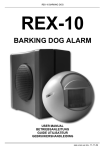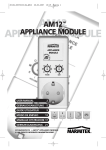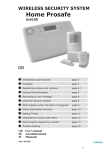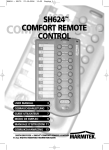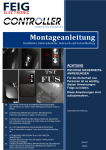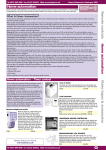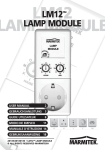Download Marmitek KR22E User manual
Transcript
REX-10 BARKING DOG REX-10 BARKING DOG ALARM USER MANUAL BETRIEBSANLEITUNG GUIDE UTILISATEUR GEBRUIKERSHANDLEIDING ADDENDUM (for all languages!) REX-10 BARKING DOG CE Declaration of Conformity UK We, X10 Europe, 3 Rue de Penthièvre - 75008 Paris - France, herewith declare that the following designated product: REX-10, is in compliance with the essential requirements and other relevant provisions of Directive 1999/5/EC. DE Wir, X10 Europe, 3 Rue de Penthièvre - 75008 Paris – France, erklären hiermit die Übereinstimmung des Gerätes REX-10 mit den grundlegenden Anforderungen und anderen relevanten Festlegungen der Richtlinie 1999/5/EC. FR Nous, X10 Europe, 3 Rue de Penthièvre - 75008 Paris - France, déclarons que le produit suivant: REX-10 les exigences essentielles et aux autres dispositions pertinentes de la directive 1999/5/CE. NL Hierbij verklaart X10 Europe, 3 Rue de Penthièvre - 75008 Paris - France dat het toestel REX-10 in overeenstemming is met de essentiële eisen en de andere relevante bepalingen van richtlijn 1999/5/EG S Por medio de la presente X10 Europe, 3 Rue de Penthièvre - 75008 Paris - France, declara que el REX-10 cumple con los requisitos esenciales y cualesquiera otras disposiciones aplicables o exigibles de la Directiva 1999/5/CE. IT Con la presente X10 Europe, 3 Rue de Penthièvre - 75008 Paris - France, dichiara che questo REX10 è conforme ai requisiti essenziali ed alle altre disposizioni pertinenti stabilite dalla direttiva 1999/5/CE. SE Härmed intygar X10 Europe, 3 Rue de Penthièvre - 75008 Paris - France - att denna REX-10 står I överensstämmelse med de väsentliga egenskapskrav och övriga relevanta bestämmelser som framgår av direktiv 1999/5/EG. SAFETY WARNINGS • To prevent short circuits, this product (except the outdoor specified products) should only be used ins ide and only in dry spaces. Do not expose the components to rain or humidity. Do not use the product close to a bath, swimming pool etc. • Only connect the adapter to the mains after checking whether the mains voltage is the same as the values on the rating labels. Never connect an adapter or power cord when it is damaged. In that case, contact your supplier. • Do not expose the components of your systems to extremely high temperatures, high humidity, strong mechanical tear, wear and strong vibrations. • The appliance must not be changed or dismantled. The entire product may not be modified. It is prohibited to open the housing, the device contains live parts. Defected pieces must be replaced by original parts. Any operation on the appliances must be done by qualified technicians. In case of damages due to a non-respect of the user guide, the guarantee does not apply. • Adapters: Only connect the adapters to the mains after you have checked whether the mains voltage corresponds with the value on the type tags. Never connect an adapter or cable when it is damaged. In that case, contact your supplier. • Batteries: keep batteries out of the reach of children. Dispose of batteries as chemical waste. Never use old and new batteries or different types of batteries together. Remove the batteries when you are not using the system for a longer period of time. Check the polarity (+/ -) of the batteries when inserting them in the product. Wrong positioning can cause an explosion. • In case of improper usage or if you have opened, altered and repaired the product yourself, all guarantees expire. The manufacturer does not accept responsibility in the case of improper usage of the product or when the product is used for purposes other than specified. • The manufacturer does not accept res ponsibility for additional damage other than covered by the legal product responsibility. REX-10 BARKING DOG REX-10 Base Console DK10: 1. Loudspeaker 2. Power Supply 3. Battery compartment (9x”C”) 4. Loudspeaker Volume 5. House Code Dial switch 6. Install. Slide switch 7. Status LED 8. Mode Switch (Arm / Dis-arm) REX-10 Outdoor Motion Sensor DM10: 1. PIR Motion Sensor 2. Dusk/Dawn Sensor 3. Battery compartment (4x“AA”) 4. House- Unit Code Dial switch 5. Test button 6. Status LED 7. Mounting clips REX-10 BARKING DOG USER MANUAL Set-Up and Operating Instructions for REX-10™ Barking Dog Alarm (DK10), Outdoor Motion Sensor (DM10E) and (optional) Key Chain Remote (KR22). Simple Set-up Follow these steps to quickly get your Barking Dog system working. Remove the battery cover on the back of Barking Dog and install 9 “C” cell alkaline batteries (observe polarity). Replace the battery cover and plug the AC power cord into any convenient AC outlet near a window or outside door where it will easily be heard by someone approaching your home. Note: batteries are for back up only, in case the AC power fails. To test the system Make sure the slide switch on the back of Barking Dog is set to RUN (to the left). Press the “A1-ON” button on the key chain remote or any other X10 controller. Barking Dog starts barking. Adjust the volume control on the back to a level that can be heard from outside your home. If you installed any (optional) X10 Light Control Modules, five seconds after barking starts Barking Dog will turn on any X10 Modules which are set to A1. The barking will stop approximately 30 seconds later, or press the “A1-OFF” button on the remote to tell Barking Dog to stop barking. If you installed any optional X10 light control modules, you can turn on any module set to A2 from the 2-ON button on the key chain remote or other X10 controller. (Modules set to A1 will turn on when Barking Dog starts barking). To learn more about installing additional accessories or changing any of the default settings, read on: Optional Remote Controls You can use several types of X10 (remote) controls to activate Barking Dog. These controllers fall into different categories: Home Automation (HA) wireless remotes, HA plug-in controllers, and security wireless remotes. HA wireless remotes such as the KR22 or the optional SH624, or any X10 RF Wall Switch like SS13 do not need to be installed. The default setting for Barking Dog is A1 so you activate Barking Dog from these remotes by pressing the 1-ON button. Pressing the 1-OFF button while Barking Dog is barking tells it to stop. REX-10 BARKING DOG HA plug-in controllers: ANY X10 controller such as the MT10 Mini Timer, SC9000 Console, CM11 Computer Interface, CM15Pro Computer interface, etc. can control Barking Dog. The default House Code and Unit Code for the DK10 is A1 so A1-ON tells Barking Dog to bark, and A1-OFF tells it to stop barking. To change Barking Dog's default setting of A1 so you can activate Barking Dog with a different code: Move the slide switch on the back of Barking Dog to INSTALL. Make sure the House Code dial on the Remote Control matches the letter you set on the back of Barking Dog. Press any button on the Remote Control. Set the slide switch back to RUN. For example if you pressed button number 5 on the Remote Control, Barking Dog will now be activated by 5-ON and silenced by 5-OFF, and it will turn on X10 modules set to number 5, five seconds after it is tripped. Motion Detector Model DM10E The included outdoor battery operated Motion Detector will tell Barking Dog to start barking whenever someone approaches your home. This motion detector can also turn lights on at dusk and turn them off again at dawn. To set up the DM10E Motion Detector Remove the screw from the front cover on the Motion Detector and remove the cover. Unclip the Motion Detector from the back plate. Remove the 2 screws from the battery compartment cover. Insert 4 “AA” alkaline batteries (observe polarity). Replace the battery cover. Attach the back plate to an exterior wall in a location where the Motion Detector will see any intruder who approaches your home. Clip the Motion Detector onto the back plate. Refit the cover. Adjust the swivel up and down for best coverage. Wait for approximately 60 seconds after installing the batteries to let the sensing circuitry settle before testing the unit. To test the DM10 Motion Detector Make sure the slide switch on the back of Barking Dog is set to RUN (to the left). Arm Barking Dog, by pressing the button on the back. The small red light on the back turns on. Walk past the Motion Detector. Barking Dog starts barking. Five seconds after barking starts Barking Dog will turn on Lamp Modules (which are set to A1). The barking will stop approximately 4 minutes later. If the Motion Detector is tripped again the sequence repeats itself, if no motion is detected for 4 minutes, Barking Dog goes quiet, and the Lamp Module set to A1 will turn off. Note: after the Motion Detector has been tripped it will not trip again for a period of 30 seconds (for longer battery life). Press the button on the back of Barking Dog to disarm it, the red light goes off. REX-10 BARKING DOG Note: the key chain remote normally controls X10 codes A1 to A4. To change the key chain’s House Code • Press and hold the first (top) ON button. The red LED blinks once. 3 seconds later, the LED blinks the current setting: 1 blink for House Code A, 2 blinks for B..... 16 blinks for P. • Release the first (top) ON button. • Press and release the first (top) ON button the appropriate number of times for the House Code you want to set. Once for A, twice for B, etc. The LED blinks for each press. IMPORTANT: Hold the button on your last press. 3 seconds later, the red LED blinks back the new setting, e.g. 3 blinks for House Code C. If you do not follow this programming sequence, the LED will stay on for 1 second and your existing setting will not be changed. To change the Unit Code for the key chain's remote (the second pair of buttons are always one # higher than the first pair, i.e. if you set the first button to 6, the second button controls 7, etc.). • Press and hold the top OFF button. The red LED blinks once. 3 seconds later, the LED blinks the current setting: 1 blink for Unit Code 1, 2 blinks for 2, 16 blinks for 16. • Release the top OFF button. • Press and release the top OFF button the appropriate number of times for the Unit Code you want. IMPORTANT: Hold the button on your last press. 3 seconds later new code blinks back. If you do not follow this programming sequence, the LED will stay on for 1second and your existing setting will not be changed. To change the battery: Pry the unit apart and fit a CR2025 Lithium 3V battery. Observe polarity. You will also need to change the code that Barking Dog responds to; see To change Barking Dog's default setting of A1. NOTE: NO CHANGES OR MODIFICA TIONS MAY BE MADE TO THE UNITS. ANY CHANGES MADE TO THE UNITS WILL VOID THE USER'S AUTHORITY TO OPERATE THE EQUIPMENT. REX-10 BARKING DOG BETRIEBSANLEITUNG Der REX-10 kann als eigenständige Einheit oder in Verbindung mit dem FunkSicherheitssystem und Haussteuerungssystem betrieben werden. Das Grundset besteht aus Zentrale DK10 mit eingebautem Hundegebell und einen AußenBewegungsmelder DM10. Das Hundegebell in der Zentrale DK10 wird über den Bewegungsmelder oder Funk-Handsender (Zubehör) aktiviert. Um die Simulation einer Anwesenheit zu perfektionieren, besteht die Möglichkeit über Lampen- oder Schaltermodule (Zubehör) Leuchten usw. zu schalten. Bei Abwesenheit oder in der Nacht kann das Hundgebell durch die Außen-Bewegungsmelder DM10 bei eingeschalteter Anlage aktiviert werden. Auch hier werden kurz nach dem Anfang des Bellens die Leuchten aktiviert und 4 Minuten nach letzter Erfassung wieder automatisch ausgeschaltet. Der Dämmeungsschalter schaltet Lampen bei Dämmerung ein und bei Tagesanbruch wieder aus. Inbetriebnahme des REX -10 (Grundset) Legen Sie die Batterien polungsrichtig in das Batteriefach des DK10 ein. Suchen Sie sich einen geeigneten Montageort im Innenraum für den DK10. Dieser Ort sollte sich in der Nähe der Haustüre befinden. Stecken Sie das Steckernetzteil PS 500 in eine vorhandene Netzsteckdose ein. Stellen Sie den Schiebeschalter auf der Rückseite von DK10 auf die Stellung Eingabe/Install und drücken Sie die Taste A1 Ein der Fernbedienung. Der DK10 bestätigt diese Anmeldung mit einem kurzen bellen. Stellen Sie nun den Schiebeschalter auf der Rückseite von DK10 wieder in Stellung Betrieb/Run zurück. Testen Sie nun die Funktion des DK10 durch Drücken der Taste A1 Ein und A1 Aus. Die Lautstärke des Hundes kann durch drehen des Lautsprecherknopfes eingestellt werden. Das System ist nun betriebsbereit. Ändern der Hauscodierung am REX -10 Wenn mehrere REX-10 in unmittelbarer Nähe (Nachbarschaft) betrieben werden oder der Systemcode A1 bereits durch ein anderes System belegt ist, können Sie die Einstellung abändern und so eine gegenseitige Beeinflussung vermeiden. Bei nachträglicher Änderung muß die Fernbedienung wieder neu im REX-10 eingebucht werden. Änderung des Systemcodes An der Rückseite des DK10 ist ein Drehschalter zum Ändern des Systemcodes eingebaut. Beachten Sie bei der Veränderung dieser Einstellung, daß die (wenn vorhanden) über den REX-10 aktivierten Schalter- oder Wandmodule sowie die Fernsteuerungen mit Systemcodeschalter alle die gleiche Systemcodestellung aufweisen. REX-10 BARKING DOG Änderung des Gerätecodes Der Gerätecode ist in der Grundstellung 1. Das bedeutet, daß DK10 über die Fernsteuerungen (KR22, SH624, etc.) durch Druck auf die Taste Kanal 1 ein oder ausgeschaltet werden kann. Wollen Sie diese Einstellung ändern, so gehen Sie wie folgt vor: 1. Nehmen Sie eine bereits an der Zentrale DK10 angemeldete Funkfernbedienung KR22. 2. Die Zentrale DK10 muß ausgeschaltet sein (LED dunkel). 3. Stellen Sie den Betriebsartenschalter auf der Rückseite der Zentrale in die Stellung Eingabe/ Install). 4. Drücken Sie nun auf die gewünschte Ein-Taste auf der Fernbedienung auf dessen Kanal Sie den DK10 einstellen wollen. 5. Stellen Sie nun den Betriebsartenschalter an der Zentrale wieder zurück in die Stellung Betrieb/ Run. 6. Die Zentrale ist nun auf den entsprechenden Kanal umgestellt und läßt sich durch Drücken auf der entsprechenden Kanal Ein und Aus-Taste ein- und ausschalten. Hinweis: Achten Sie bitte darauf, daß nach einer Umstellung des Geräte und Systemcodes auch die entsprechenden Wand und Schaltermodule auf den gleichen Hauscode eingestellt sind. Erweiterung durch Wand- oder Steckermodule (Zubehör) Um die Abschreckung noch zu erhöhen, werden über ein oder mehrere Steckeroder Wandmodule (Zubehör) Leuchten ca. 5 Sekunden nach Aktivierung des Hundegebells automatisch eingeschaltet und nach ca. 4 Minuten nach letzter Erfassung wieder automatisch ausgeschaltet. Diese Funktion wird von REX-10 automatisch ausgelöst. Durch Drücken der Tasten Lampen Ein oder Lampen Aus an der Funk-Fernbedienung können die entsprechenden Lampen auf Adresse 2 auch manuell geschaltet werden. Hinweis: Die verwendeten Lampenmodule müssen auf die gleiche Hauscodierung wie die Zentrale eingestellt werden. Erweiterung mit PIR Bewegungsmelder DM10 Der Bewegungsmelder wir einfach in der Nähe der Eingangstüre im Außenbereich montiert und meldet somit jede Bewegung in seinem Erfassungsbereich über Funk an den DK10 weiter. Ist der REX-10 nun über den Taster eingeschaltet (LED leuchtet) dann beginnt DK10 unverzüglich nach einer Erfassung durch den Bewegungsmelder an zu bellen. 5 Sekunden danach werden die Leuchten über die Lampenmodule auf Adresse 1 Grundeinstellung eingeschaltet. Das Bellen verstummt nach 4 Minuten nach letzter Erfassung einer Bewegung durch den Bewegungsmelder DM10. Wird für die Dauer von 4 Minuten keine Bewegung mehr wahrgenommen stellt REX-10 seine Tätigkeit ein und die Lampen werden durch die Lampenmodule automatisch wieder ausgeschaltet. Nach jeder Erfassung einer Bewegung, stellt der Bewegungsmelder seine Tätigkeit aus Stromspargründen für 30 Sekunden ein. REX-10 BARKING DOG Installation und Inbetriebnahme des Bewegungsmelders DM10 Lösen Sie die Schraube auf der Frontseite des Melders und nehmen Sie die Frontabdeckung ab und nehmen Sie den Bewegungsmelder durch seitliches Drücken auf die Halterung (7) von der Rückplatte ab. Öffnen Sie das Batteriefach auf der Rückseite durch Lösen der zwei Schrauben und nehmen Sie den Deckel ab. Stellen Sie den Systemcodeschalter und Geräteadresse (Grundeinstellung A1) gleich wie beim DK10 ein. Setzen Sie die Batterien polungsrichtig in das Batteriefach ein, schließen Sie das Batteriefach und drehen die beiden Schrauben wieder ein. Warten Sie nach dem Einlegen der Batterien und Montage ca. 60 Sek. ab, danach ist der Bewegungsmelder einsatzfähig. Stellen Sie den Schiebeschalter auf der Rückseite der eingesteckten Zentrale DK10 in die Stellung Eingabe (Install) und drücken Sie die Taste “Test” auf der Rückseite des Bewegungsmelders DM10. Die Zentrale DK10 bestätigt diese Einstellung mit einem Bellen (Zentrale muß ausgeschaltet sein, LED leuchtet nicht). Setzen Sie das Frontgehäuse wieder auf den Melder auf und befestigen Sie dieses. REX-10 ist nun betriebsbereit und kann nur im eingeschalteten Zustand (LED leuchtet) über den Bewegungsmelder aktiviert werden. Eine Aktivierung über die Fernbedienungen ist in jeder Betriebsart möglich. KR22 Fernbedienung (Zubehör) Die KR22 wird werksseitig mit HausCode A geliefert. Die oberste Taste bedient UnitCode 1, die nächste 2, 3 und 4. Die zwei untersten Tasten sind Dimmtasten. Ändern des Hauscodes (Systemcodes) 1. Drücken Sie auf die oberste Taste AN und halten diese fest. Die rote Leuchtanzeige blinkt kurz. Nach 3 Sekunden wird die aktuelle Einstellung angezeigt: 1x blinken ist HausCode A, 2x blinken ist HausCode B, usw. 2. Die oberste Taste loslassen. 3. Drücken Sie nun jeweils kurz auf die gleiche oberste AN-Taste um den gewünschten HausCode einzustellen (1x=A, 2x=B, usw.) Die rote Leuchtanzeige blinkt jedesmal, wenn Sie die Taste drücken. 4. Halten Sie beim letzten Drücken die Taste fest. Nach 3 Sekunden zeigt die Leuchtanzeige den eingestellen HausCode an. Lassen Sie die Taste wieder los. Ändern des Unitcodes (Gerätecodes) 1. Drücken Sie auf die oberste AUS-Taste und halten diese fest. Die rote Leuchtanzeige blinkt kurz. Nach 3 Sekunden wird die aktuelle Einstellung angezeigt: 1x blinken ist UnitCode 1, 2x blinken ist UnitCode 2, usw. 2. Die oberste AUS -Taste loslassen. 3. Drücken Sie nun jeweils kurz auf die gleiche oberste AUS-Taste um den gewünschten UnitCode einzustellen (1x=1, 2x=2, usw.) Die rote Leuchtanzeige blinkt jedesmal, wenn Sie die Taste drücken. 4. Halten Sie beim letzten Drücken die Taste fest. Nach 3 Sekunden zeigt die Leuchtanzeige den UnitCode an. Lassen Sie die Taste wieder los. Wechseln der Batterie Entfernen Sie die Rückseite des Gehäuses der Fernbedienung. Schieben Sie die Batterie aus dem Halter auf der Printplatte und ersetzen Sie die Batterie mit einer identischen 3 V Lithium-Batterie (KR22; 2 x Typ CR2016). Achten Sie hierbei auf die Polarität (Oberseite ist +). REX-10 BARKING DOG Mise en service et mode d’emploi pour le “Barking Dog” REX 10™ (DK10), le détecteur de mouvements (DM10E) et la télécommande porte clé (KR22, optionnel). Mise en service simple Suivez les étapes suivantes pour mettre rapidement en service votre système “Barking Dog”. Ouvrez le compartiment piles et installez 9 piles de type “C” en respectant la polarité. Refermez le compartiment piles et branchez le câble secteur dans une prise secteur près d’une fenêtre ou d’une porte d’où les personnes approchant de votre maison pourront facilement l’entendre Note: Les piles sont présentes uniquement dans le cas d’une panne secteur. Test du système Mettre l’interrupteur à glissière situé à l’arrière du “Barking Dog” en position RUN (à gauche). Appuyez sur la touche “1-ON” de la télécommande porte clé ou de toutes autres télécommandes X10. Le “Barking Dog” commence à aboyer. Réglez le niveau du volume à l’arrière à un niveau qui puisse être entendu depuis l’extérieur de votre maison. Si vous avez installé un module de contrôle de lumière X10 (optionnel), 5 secondes après le début de l’aboiement, le “Barking Dog” allumera tous modules X10 réglés sur l’adresse A1. L’aboiement s’arrêtera environ 30 secondes plus tard ou si vous appuyez sur la touche “A1-OFF” d’une télécommande X10. Si vous avez installez un module de contrôle de lumière X10, vous pouvez allumez les modules réglés sur l’adresse A2 en appuyant sur la touche 2-ON de la télécommande porte-clé ou de toutes autres télécommandes X10. (Les modules réglés sur A1 se mettent en marchent 5 secondes après que le “Barking Dog” ait commence à aboyer). Pour en apprendre plus sur la façon d’installer de nouveaux accessoires ou changer les réglages par défaut, lire ci-dessous: Télécommandes optionnelles Vous pouvez utiliser différents types de télécommandes X10 pour déclencher le “Barking Dog”. Ces télécommandes se trouvent dans différentes catégories de produits : Télécommandes domotiques, contrôleurs domotiques reliés au secteur, et télécommandes de sécurité. REX-10 BARKING DOG Télécommandes domotiques: les télécommandes optionnelles que la KR22, la télécommande SH624 ou encore les interrupteurs radio comme le SS13 n’ont pas besoin d’être installés. Le réglage par défaut du “Barking Dog” est A1, aussi pour le déclencher d’une de ces télécommande il suffit d’appuyer sur la touche 1 - ON. Appuyer sur 1 - OFF lorsque le “Barking Dog” aboie permet de l’arrêter. Contrôleurs domotiques: Tous contrôleurs X10 tel que le mini-contrôleur MT10, la console SC9000, les interface PC CM11 et CM15Pro etc. peuvent contrôler le “Barking Dog”. Le code maison et le code unité par défaut du DK10 sont A1, A1-ON permettra donc de déclencher l’aboiement et A1- OFF de l’arrêter. Pour modifier le réglage par défaut A1 du “Barking Dog” de façon à activer le “Barking Dog” à l’aide d’un code différent: mettez l’interrupteur à glissière se trouvant à l’arrière du “Barking Dog” dans la position INSTALL. Vérifiez que le code maison (code lettre) de votre télécommande correspond bien au code lettre réglé à l’arrière du “Barking Dog”. Appuyez sur la touche de la télécommande que vous désirez utilisez pour déclencher le “Barking Dog”. Remettez l’interrupteur à glissière en position RUN. Par exemple, si vous appuyez sur la touche N° 5 de la télécommande, le “Barking Dog” sera activé lorsque vous appuierez sur la touche 5-ON (les modules X10 réglés sur l’adresse 5 seront aussi activés 5s après la commande) et s’arrêtera lorsque vous appuierez sur la touche 5-OFF,. Détecteur de mouvements DM10 Le détecteur de mouvements inclus permet de déclencher le “Barking Dog” lorsque quelqu’un s’approche de votre maison. Ce détecteur permet aussi d’allumer des lumières lorsque la luminosité devient trop faible au crépuscule et de les éteindre à l’aube. Réglage du détecteur de mouvements DM10 Enlevez la vis du capot avant du détecteur de mouvements et enlevez le capot. Déclipsez le détecteur de mouvements de son socle. Enlevez les 2 vis du couvercle du compartiment piles. Insérez 4 piles alcalines “AA” en respectant la polarité. Replacez le couvercle du compartiment piles. Fixez le socle sur un mur extérieur d’ou le détecteur de mouvements pourra « voir » toutes personnes s’approchant de votre maison. Reclipsez le détecteur de mouvements sur le socle. Re-fixez le capot. Ajustez l’inclinaison du détecteur de façon à avoir le maximum de couverture. Attendez environ 60 secondes après l’installation des piles pour tester le système. Pour tester le DM10 Vérifiez que l’interrupteur à glissière se trouvant à l’arrière du “Barking Dog” se trouve en position RUN (vers la gauche). Armez le barking dog en appuyant sur le bouton situé à l’arrière. La LED rouge située à l’arrière s’allume. Bougez devant le détecteur de mouvements, le “Barking Dog” commence à aboyer. Cinq REX-10 BARKING DOG secondes plus tard, le “Barking Dog” allumera les modules X10 réglés sur l’adresse A1. Le “Barking Dog” s’arrêtera environ 4 minutes plus tard. Si le détecteur de mouvements est déclenché de nouveau, la séquence complète se répètera de nouveau. Si aucun mouvement n’est détecté dans les 4 minutes, le “Barking Dog” éteint les modules X10 réglés sur A1. Note: après son déclenchement, le détecteur de mouvements est inactif pour une période de 30s. Appuyez sur le bouton à l’arrière du “Barking Dog” pour le désarmer. Télécommande porte-clés KR22 Par défaut, le "code Maison" de la KR22 est A. Les 2 touches situées en haut du KR22 commande l'adresse 1, les touches suivantes commande 2, 3 et 4 touches suivantes commande l'adresse 2 et les 2 boutons inférieurs permettent de faire varier l'intensité du dernier module commandé. Pour changer le "Code Maison" 1. Maintenez appuyer la première touche coté ON. La LED rouge clignote une fois puis 3 secondes plus tard elle clignote pour indiquer le "Code Maison" actuel: 1 clignotement pour le code A, 2 clignotements pour le code B, …, 16 clignotements pour le code P 2. Relâchez la touche. 3. Appuyez et relâchez la 1ère touche (coté ON) autant de fois que nécessaire pour le code que vous voulez entrer. Une fois pour A, 2 fois pour B, …, 16 fois pour P. IMPORTANT: Maintenez la touche lors du dernier appui. 3 secondes plus tard la LED rouge va clignoter indiquant le code que vous venez d'entrer, ex.: 3 clignotements pour le code C. Si un problème survient durant cette procédure, la LED s'allume durant une seconde et le code reste inchangé. Pour changer le "Code Unité" Il est possible de programmer un nouveau "Code Unité" pour la première touche, la touche suivante commandant alors automatiquement cette adresse plus 1 (ex: si l'on reprogramme l'adresse 6 pour la première touche, la seconde touche aura l'adresse 7). 1. Maintenez appuyez la première touche coté OFF. La LED rouge clignote une fois puis 3 secondes plus tard elle clignote pour indiquer le "Code unité" actuel: 1 clignotement pour le code 1, 2 clignotements pour le code 2, …, 16 clignotements pour le code 16 2. Relâchez la touche . 3. Appuyez et relâchez la 1ère touche autant de fois que nécessaire pour le code que vous voulez entrer: une fois pour le code 1, deux fois pour le code 2, …, seize fois pour le code 16. IMPORTANT: Maintenez la touche lors du dernier appui. 3 secondes plus tard la LED rouge va clignoter indiquant le code que vous venez d'entrer, ex.: 3 clignotements pour le code 3. Si un problème survient durant cette procédure, la LED s'allume durant une seconde et le code reste inchangé. Pour changer la pile Ouvrir la télécommande. Remplacez la pile usagée par une pile (3V lithium) du même type (KR22: 2 x CR2016) en respectant les polarités. REX-10 BARKING DOG GEBRUIKERSHANDLEIDING Gebruikershandleiding voor REX-10™ Barking Dog Alarm (DK10), Bewegingsmelder voor buitengebruik (DM10E) en (optionele) Key Chain Afstandsbediening (KR22). Eenvoudige opstelling Volg deze stappen om eenvoudig het Barking Dog systeem in werking te stellen. Open het batterijvak aan de achterzijde van de Basisconsole en installeer 9 stuks 1,5V “C” batterijen (let op het + en – teken). Sluit het batterijvak en steek de stekker van de PS500 voedingsadapter in een stopcontact nabij een raam of buitendeur, zodat de luidspreker goed hoorbaar is wanneer iemand het huis nadert. Opmerking: batterijen zijn alleen geschikt voor back-up in geval van een stroomstoring. Het systeem testen Zorg ervoor dat de Mode-schakelaar aan de achterzijde in de RUN-stand staat. Druk op de A1ON toets van een willekeurige X10 controller en de Barking Dog start met blaffen. U kunt het volume instellen aan de achterzijde van de unit, zodat het geluid buiten goed te horen is. Wanneer u ook (optionele) lamp en apparaat modules geïnstalleerd heeft op adres A1, zullen deze ongeveer 5 seconden nadat het blaffen begon aangeschakeld worden. De Barking Dog zal ongeveer na 30 seconden automatisch stoppen met blaffen, of direct wanneer u het commando A1 OFF zendt. Wanneer u de optionele X10 lamp en apparaat modules in uw huis heeft geïnstalleerd, kunt u deze bedienen met de overige toetsen van uw afstandsbediening. Bijvoorbeeld de A2 ON toets schakelt alle modules op adres A2 aan. (Modules die op adres A1 ingesteld zijn, zullen aanschakelen zodra de Barking Dog begint te blaffen). Wanneer u meer wilt weten over toevoegen van optionele accessoires en het veranderen van fabrieksinstellingen, lees dan verder: Optionele afstandsbedieningen U kunt diverse verschillende typen X10 controllers en afstandsbedieningen gebruiken om de Barking Dog te activeren. Deze (afstands)-bedieningen zijn in verschillende categorieën in te delen: REX-10 BARKING DOG Home Automation afstandsbedieningen: zoals bijvoorbeeld de KR22 key-chain remote, de 16 kanaals afstandsbediening SH624 en de draadloze schakelaar SS13 behoeven niet geïnstalleerd te worden. De standaard adres code voor de Barking Dog is A1, dus wanneer A1 aangestuurd wordt vanaf bovenstaande afstandsbedieningen zal Barking Dog direct reageren. Home Automation plug-in controllers: zoals bijvoorbeeld MT10 Mini Timer, SC9000 Controller, CM11 Computer Interface, CM15Pro Computer interface etc. kunnen de Barking Dog bedienen. Om het standaard adres A1 van de Barking Dog te wijzigen, zodat deze reageert op een andere code dient u de volgende stappen te volgen: Zet de Mode-schakelaar in de stand INSTALL. Zorg dat de Huis Code van de afstandsbediening overeenkomt met die van de DK10 basisconsole. Zend de nieuwe Unit Code met uw afstandsbediening. Zet de Mode-schakelaar terug in de RUN stand. Wanneer u bijvoorbeeld toets 4-ON van uw afstandsbediening gebruikt heeft, zal de Barking Dog vanaf nu reageren op 5-ON en 5-OFF, en zal alle modules met adres HC5 aanschakelen 5 seconden nadat de Barking Dog geactiveerd is. Bewegingsmelder voor buitengebruik DM10E De bijgevoegde batterij gevoede bewegingsdetector is bedoeld om, zodra iemand in de buurt van uw huis komt, de aanwezigheidsdetectie door te geven aan de Barking Dog zodat deze begint te blaffen. De bewegingsmelder bevat tevens een geïntegreerde schemerschakelaar die automatisch lampen aanstuurt. Instellen van de DM10 Bewegingsmelder Neem de schroef aan de voorzijde van de DM10 los en haal de afdekkap van de bewegingsmelder af. Neem de rugplaat van de melder af. Haal de schroeven van het batterijvak los. Installeer 4 “AA” batterijen in het vak en let daarbij op de polariteit. Plaats het batterij klepje terug. Bevestig de rugplaat van de bewegingsmelder op een plaats waar deze een groot detectie bereik heeft. Klik de bewegingsmelder terug op de rugplaat en schroef de afdekplaat weer vast op de melder. Verdraai de PIR lens voor een beter en specifieker bereik. De unit zal ongeveer 60 seconden in rust stand moeten zijn na het installeren van de batterijen, voordat de melder getest kan worden. Testen van de DM10 Bewegingsmelder Zorg dat de Mode-schakelaar op de achterzijde van de Barking Dog in de RUN stand staat. Alarmeer de Basis Console door op de ARM/DISARM toets te drukken die op de achterzijde van de Barking Dog zit. De rode LED naast de knop licht op ter confirmatie. Beweeg voorlangs de DM10 bewegingsmelder, de Basis Console zal beginnen met blaffen. Vijf seconden later zal de Basis Console lamp en apparaatmodules op adres A1 (of herziene adres) aanschakelen. Het REX-10 BARKING DOG blaffen stopt na ongeveer 4 minuten. Wanneer de bewegingsmelder weer beweging detecteert begint de procedure opnieuw. Wanneer geen beweging is gedetecteerd voor 4 minuten zal de Basis Console de lampen en apparaten op A1 uitschakelen. Opmerking: om batterijen te sparen zal NA een detectie de bewegingsmelder niet opnieuw detecteren binnen een tijd van 30 seconden. Om de test af te sluiten, drukt u de ARM/DISARM toets in. Opmerking: De KR22 key chain afstandsbediening bedient standaard X10 adres A1 tot A4. Het veranderen van de Huis Code 1. Druk op de bovenste toets AAN en houd deze ingedrukt. De rode LED knippert kort. Na 3 seconde wordt de huidige instelling weergegeven: 1x knipperen is Huis Code A, 2x knipperen is Huis Code B, enz. 2. Laat de bovenste AAN toets los. 3. Druk nu voor de gewenste Huis Code telkens kort op dezelfde bovenste AAN toets (1x =A, 2x=B, etc.). De LED knippert bij iedere keer dat u de toets indrukt. 4. Houd bij de laatste keer de toets ingedrukt. Na 3 seconden geeft de LED de ingestelde Huis Code weer. Laat nu de toets los. Het veranderen van de Unit Code Bij het instellen van de Unit Code wordt de bovenste toets ingesteld op de gewenste Unit Code. De volgende toets is altijd automatisch één Unit Code hoger dan de eerste (b.v. wanneer u de eerste toets instelt op Unit Code 6, dan is de volgende toets automatisch Unit Code 7). 1. Druk op de bovenste UIT toets en houd deze ingedrukt. De rode LED knippert kort. Na 3 seconde wordt de huidige instelling weergegeven: 1x knipperen is Unit Code 1, 2x knipperen is Unit Code 2, enz. 2. Laat de bovenste UIT toets los. 3. Druk nu voor de gewenste Unit Code telkens kort op dezelfde bovenste UIT toets (1x =1, 2x=2, etc.). De LED knippert bij iedere keer dat u de toets indrukt. 4. Houd bij de laatste keer de toets ingedrukt. Na 3 seconden geeft de LED de ingestelde Unit Code weer. Laat nu de toets los. Het verwisselen van de batterij Verwijder de achterzijde van de behuizing van de afstandsbediening. Schuif de batterij uit de houder op de printplaat en vervang de batterij met een identieke 3V lithium batterij (KR22: 2 x type CR2016). Let hierbij op de polariteit (bovenzijde is +). REX-10 BARKING DOG Troubleshooting In general X10 products are extremely easy to install and very reliable. Like other electronic equipment, they do require proper set-up for correct operation. If you experience any problems, first go through this troubleshooting guideline. Having trouble with just one device... - Does the X10 controller work with other modules? If it doesn’t refer to «Things to check if NOTHING works…». - Is the module you are trying to control completely plugged into the wall outlet? - Is the switch for the light or appliance you are trying to control turned on? - Does the light or appliance work OK if y ou plug it directly into an outlet? - Is the module plugged into a surge protector? A surge protector might block signals from your interface or controller! - Noise on your house wiring could cause a module not to work at all or only work intermittently. Although not very likely, as special circuitry has been designed into the X10 modules and CE product standards require that electrical devices do not generate noise, check to see if any of these (noisy) devices are operating when you are having problems : Wireless intercoms in transmit (talk) mode, Baby Monitors that transmit over your house wiring, Wireless Doorbells that use the house wiring, Laser Printers, Electric Motors (old ones), Electric hair dryers, Electric shavers, Vacuum cleaners, Floor scrubbers, Electric Carving Knives, Food Processors, Blenders, Mixers, Micro-wave ovens. To determine if you have an interference (noise) problem, unplug anything that you suspect might be causing the problem and try controlling your device again. Noisy devices could be anywhere in your house, but start looking around the area that you are having a problem. There is a device available called a Plug-in Noise Filter (FM10) that will reduce the noise injected into the house wiring from a noisy device. You plug the noisy device into the filter and then plug the filter into the wall outlet. Contact X10 Europe for your nearest supplier. - If you cannot locate any things that are interfering with your system, try using a different module of the same type at this same location in your home. Remember to set the correct House Code/Unit Code on the new module. If this fixed the problem, the original module is possibly defective. - If no modules work in that location, you may have a problem with the wall outlet, you may have a noise problem as describe above, or you may have a problem with your house wiring. Contact your local electrician. Things to check if NOTHING works...... - Is the X10 controller plugged into a working outlet? Is the outlet controlled by a wall switch? If so, is it turned on? - Is the House Code set correctly? - If you still cannot control any modules, plug your controller and module into the same outlet (using a non surge protected outlet strip, if necessary). See if you can control this module. If not, contact your supplier for help. - If it does work correctly with the controller and the module into the same outlet, try plugging the module in where you originally had it. If it doesn’t work when you plug the module in somewhere else in your home (try sev eral different locations and several modules of the same type), contact your supplier for help. PLC Auto Tester A PLC Auto Tester, containing a Signal Strength Indicator and Test Transmitter, is available for checking if the X10 PLC signals arrive in good shape at the point where the receiver modules are. Please contact your supplier for more details. Amendments/Additions to 2007 manual included with the DK10 PLC = Power Line Communications – X10 Communications on the Mains Wiring RF = Radio Frequency – Wireless Transmitters (DM10E, MS13E, KR22E, etc) House Code = X10 House Code A – P Unit Code = X10 Unit Code 1-16 PIR HA = Passive Infra-Red Movement Detector HA (DM10E, MS13E) PIR Secured = Passive Infra-Red Movement Detector Security (MS18E/MS90) You can assign optional security remotes and sensors (Motion and Door/Window) to the console. These can be used to arm/disarm respectively trip the console. (The operation of the tamper switch on the PIR and door/window sensors: Currently, this will operate as if the sensor has been tripped – so, with these changes, the tamper switch will trigger the 4 minute barking sequence when the dog is armed). Home Automation modes: 1) Home Automation Mode (ARM LED not lit): • When sent X10 RF commands on the correct X10 HOUSE CODE/X10 UNIT CODE combination, the dog does not bark • When sent X10 PLC commands on the correct X10 HOUSE CODE/X10 UNIT CODE combination, it starts/stops the barking – The DK10 will bark for 30 SECONDS with commands received via PLC • Console works as X10 PLC Transceiver for dusk/dawn detection from PIR to control e.g. a light on PIR X10 HOUSE CODE/X10 UNIT CODE+1 on(dusk)/off(dawn). • Console works as standard RF/PLC transceiver. All X10 UNIT Codes/Commands to the set X10 HOUSE CODE are passed on to the power line. 2) Home Automation Mode (ARM LED lit, manual control): • When sent X10 RF commands (via the DM10E or optional KR22E) on the correct X10 HOUSE CODE/X10 UNIT CODE combination, it starts/stops the barking – The DK10 will bark for 4 MINUTES with commands received via RF. Please see Trigger Period on page 2 for further information about the time length of barking Note: (If you see only a 30 second bark length, then your premises/neighbor must have a X10 Transceiver module set to the same HOUSE CODE – to fix this, change the DK10/DM10 HOUSE CODE to another letter) • When sent X10 PLC commands on the correct X10 HOUSE CODE/X10 UNIT CODE combination, it starts/stops the barking – The DK10 will bark for 30 SECONDS with commands received via PLC • With RF the unit does respond and is tripped to all the set X10 HOUSE CODE/X10 UNIT CODE. So default X10 HOUSE CODE=A/X10 UNIT CODE=1, and this can be set by changing the code wheel for the X10 HOUSE CODE, and sliding the switch to INSTALL and send the respective X10 UNIT CODE via any X10 standard RF code. • When tripped, after a couple of seconds the Console sends the PLC ON command on the Console Address; After 4 minutes the PLC OFF command is send to the same address. This is to switch on a lamp or X10 Unit Code. Secured Modes: 3) Secured mode 1 (unit set to RUN, and ARMED LED off, disarmed by security remote DISARM, or manually): • Console works as X10 PLC Transceiver for dusk/dawn detection from PIR to control e.g. a light on PIR X10 HOUSE CODE/X10 UNIT CODE+1 on(dusk)/off(dawn). • Console works as standard RF/PLC transceiver. All X10 UNIT Codes/commands to the set X10 HOUSE CODE are passed on to the power line. • When sending X10 PLC command on the correct X10 HOUSE CODE/X10 UNIT CODE combination, it starts/stops the barking. • Console works as X10 PLC Transceiver for security lights, in case of security lights light on/of button KR18/KR10/21, the console sends X10 HOUSE CODE/X10 UNIT CODE+1 on/off. SH600 does not have this button • Console responds to PANIC button of assigned security remotes; Panic RF will trip the console for 30 seconds. 4) Secured mode 2 (unit set to RUN, and ARMED LED lit, armed by security remote ARM, or manually): • Idem as Secured Mode 1 + • With RF the unit does respond and is tripped to the set X10 HOUSE CODE/X10 UNIT CODE. So default X10 HOUSE CODE=A/X10 UNIT CODE=1, and this can be set by changing the code wheel for the X10 HOUSE CODE, and sliding the switch to INSTALL and send the respective X10 UNIT CODE via any X10 standard HA RF code. Trigger Periods: The trigger period operates as follows: • When triggered, the unit will immediately start barking • 5 seconds after a trigger, the unit code (X10 UNIT CODE) + On power line signal will be sent • 4 minutes later, the unit will cease barking and X10 UNIT CODE + Off power line signal will be sent If the unit is triggered and then receives another trigger a minute later, the response will be as follows: • When initially triggered, the unit will immediately start barking • 5 seconds after a trigger, the unit code (X10 UNIT CODE) + On power line signal will be sent • When the new trigger is received (assume after a minute) the alarm timer will be reset to 4 minutes • 5 seconds after the new trigger, the unit code (X10 UNIT CODE) + On power line signal will be sent • 4 minutes after the new trigger, the unit will cease barking and X10 UNIT CODE + Off power line signal will be sent So, in this example, the barking time has been extended by one minute as a result of the new trigger. In case of PANIC code: Panic Panic 30 seconds - the second panic does not retrigger Panic Sensor max: 30 seconds plus 4 minutes for the alarm Sensor Panic 4 minutes, the panic is ignored Sensor Sensor max: 7:59 minutes if the second alarm was received at 3:59 Panic Panic Sensor Sensor Panic Sensor Panic Sensor max: 60 seconds - the second panic DOES retrigger max: 30 seconds plus 4 minutes for the alarm 4 minutes, the panic is ignored max: 7:59 minutes if the second alarm was received at 3:59
This document in other languages
- français: Marmitek KR22E
- Deutsch: Marmitek KR22E
- Nederlands: Marmitek KR22E


















